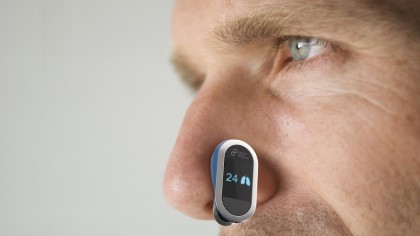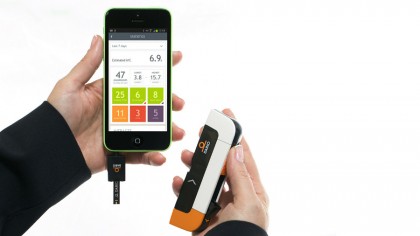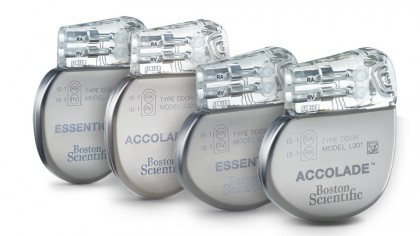How the Internet of Things will revolutionise medicine
A new dawn in patient care is almost upon us
What about wearables?
What started with activity trackers able to measure steps and monitor sleep is evolving fast. Heart-rate measurements are useful, but respiratory rate – the 'forgotten bio-sign' – is often neglected by automated monitoring systems.
Cambridge Design Partnership's First Response Monitor biometric device effortlessly measures both in an effort to help treat multiple trauma patients in disasters and battlefield situations where taking such measurements wastes time. The real-time data is sent over Bluetooth to a smartphone app or tablet, and can be analysed as part of a group of patients.

What will health wearables do next?
Next-gen wearables will measure hydration and even help with obesity. "Expect sophisticated and discreet hydration and nutrition monitoring to be a large part of the sensor future for 2020," says Collette Johnson, Medical Business Development Manager at design and innovation house, Plextek Consulting, in her paper Patient of the Future: 2020.
She predicts a simple sticking plaster sensor attached to the chest to measure hydration levels using sensors that can read heart acceleration, humidity, pressure and temperature. Obesity could be treated with sensors, too. "Ingestible sensors could track what a patient has eaten, compared to their mood diaries recorded on a mobile application, enabling the NHS to clearly monitor the comparison," she says. This could help crack the problem of why people overeat.
Sensors also power Motech's 'telecare' product, the CareClip, a wearable that can be tracked and monitored. The product used to run on analogue tech, so only worked if the wearer fell while inside their home, but now uses a SIM card from Jasper. Also using the mobile phone network is Boston Scientific, which extracts patient's data wirelessly from implanted pacemakers and transmits the data to doctors, regardless of the location of the wearer.
Meanwhile, TTP is pioneering battery-free, ultra-low power wireless smart sensors embedded in titanium orthopaedic implants, which allow remote wireless monitoring of both performance and the healing process. Amazingly, they're powered by biological energy sources, radio waves, vibration and heat, and connect to smartphones or tablets using ultra-low power Bluetooth technology or Near Field Communications (NFC).

Can IoT sensors play a part in the home?
In research by Trustmarque and YouGov in July, 81% of British respondents said they would like to see more connected devices used in healthcare, with half prioritising the ability to monitor vulnerable people. This is where sensors come in.
Are you a pro? Subscribe to our newsletter
Sign up to the TechRadar Pro newsletter to get all the top news, opinion, features and guidance your business needs to succeed!
An R&D team at Nominet – the organisation that looks after the smooth running of the UK internet – has created PIPS, round buttons that light up to guide people with memory loss through a sequence of tasks that make up their daily routines. It runs on a phone app and online, so if any part of the routine isn't complete, care providers get an alert via email or text message.
"The integration of sensor technology within everyday life will help dementia patients by facilitating safe monitoring of the patient's wellbeing without causing distress or panic," says Johnson. "The integration of sensors within everyday objects, such as kettles or even a TV, will ensure dementia patients are relaxed while recording valuable trend data (and) the same concept will apply for home monitoring for both the ageing and those on life support."
Analysts predict the sensor market in consumer healthcare will reach a value of $47.4 billion (£31 billion) by 2020.

The reach – and limitations – of the IoT in health
"As the IoT evolves, and devices and data become even more integrated, we'll see doctors and clinicians armed with the ability to aid patients through more gateways, such as monitoring a patient's response to treatment through a modified wearable, or quickly accessing and sharing test results rather than waiting on the lengthy process of procuring data from a test laboratory," says Dr Jurgi Camblong from data-driven medicine company Sophia Genetics.
However, Camblong insists that truly personalised medicine – which is what the IoT is ultimately striving for – requires knowing how your body is functioning, and the role of sophisticated algorithms that search a patient's genetic data for a particular genetic defect. That can play a huge role in the diagnosis and treatment of diseases such as cancer.
What about artificial intelligence?
Given the data that will be produced by the IoT in healthcare, computational engines like IBM's Watson will be crucial both for creating apps for patients at home, and for medical staff who need to consult the latest medical research at a moment's notice.
The IoT and healthcare might be focused, for now, on the gadgets and wearables that collect data in ever more inventive ways, but it's what's done with that data that really counts. Only then will we get personalised, automated healthcare that uses real-time data and the very latest techniques.
- 1
- 2
Current page: Health wearables and artificial intelligence
Prev Page Introduction and online surgical toolsJamie is a freelance tech, travel and space journalist based in the UK. He’s been writing regularly for Techradar since it was launched in 2008 and also writes regularly for Forbes, The Telegraph, the South China Morning Post, Sky & Telescope and the Sky At Night magazine as well as other Future titles T3, Digital Camera World, All About Space and Space.com. He also edits two of his own websites, TravGear.com and WhenIsTheNextEclipse.com that reflect his obsession with travel gear and solar eclipse travel. He is the author of A Stargazing Program For Beginners (Springer, 2015),
